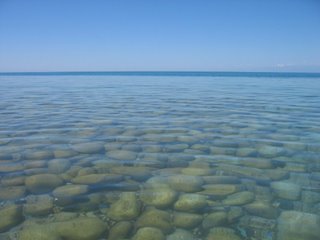
July 23, 2006
I had big plans for the last day of my Issyk-Kul loop. I wanted both to hike
through the Jeti-Oguz canyon to the Valley of the Flowers, and to bike another 60 kilometers or so to finish up in Tyup. So I was up and outdoors at 7:20, beginning my hike.
I walked alone for about an hour along a gushing river that roared in my ears. Above me rose pine-covered slopes. As I followed the winding river through the canyon, I’d occasionally cross it on bridges made from tree trunks.
A few cars came by. When three young Dungan men from the Karakol region offered me a ride, I accompanied them to the Valley of the Flowers. They continued on further, to the summit and to a waterfall. I sat in the large meadow, where purple and yellow wildflowers shot up from the grass. I watched horses and cows running free and listened to their moos and whinnies, as though I was in a playground for animals. They seemed so wild and happy and free. And they seemed to belong there. I, as the only human around, was a visitor to their world. Again, Kyrgyzstan amazed me.
I returned to the sanatorium by foot, crossing a moraine, then walking back through the canyon. At the end of the canyon, the seven red cliffs stood sentinel. The story goes that once a king stole the wife of another king. The king who lost his wife went to see a wise man and asked how to make the king-thief suffer as much as possible. After hesitating, the wise man recommended that he kill his former wife, letting the king-thief have a dead wife, but not a live one. At a funeral feast in the mountains a few days later, the king sat next to his former wife. As the last bulls were slaughtered, he drove a knife into his wife’s heart. Blood flowed from her heart, carrying the seven bull carcasses and the king-murderer with it into the mountains and the valley. The seven bulls turned into seven mountains.
I started off my ride coasting for almost the entire 15 kilometers of dry, scrubby landscape I’d struggled up the night before. One boy on horseback gave me the finger, the first negative interaction I’d during in the entire ride. Another boy had pestered me for money the night before, and the service at the sanatorium was awful. Though I wasn’t in Jeti-Oguz long enough to make much of a fair judgment, I did get the sense that the people in the area were less friendly (or, as the locals say, “civilized”) than other areas I’ve traveled to (with the exception of the remote southern village of Kojo-Kelen, which I felt a similar reception).
I continued along the quiet, calm, green, tree-lined road I’d been on the day before, with fields on either side, mountains rising up behind them. I passed a lot of horse-drawn wagons, with a wooden arch rising over the horse. In one, I saw an entire family packed in the cart with a new, modern baby carriage. Others traveled with a cow on board. And in many of them, either the passenger, or even the driver, lay asleep in the cart, trusting the horse to move ahead and avoid getting hit by passing cars.
After a much anticipated stop in Karakol for a high-quality lunch and some communication at the internet café, I decided to make the final push on to Tyup.
The road to Tyup is a rolling up and down. I had to make one major climb, but was rewarding with two wonderful downhills at 12% grade, some of the best coasts of the trip.
The tree lined road mainly provided views of fields – an array of pastels in green, yellow, blue and white. A woman in a scarf and a young girl climbed up the mountain, running around on either side of the road, looking at the views – of the newly reappeared Issyk-Kul on one side, undulating meadows on the other. The woman gazed over the meadow with her hand on her forehead, then quickly ran back downhill when she saw me looking at her.
I liked the atmosphere in Tyup. Swimmers walked happily to and from the canal, carrying plastic bags and wearing flip-flops. I twice saw men giving women a ride on bikes – both an older and a younger couple. Sunflowers tilted their heads in the gardens behind people’s homes.
And when I approached the area where I’d set off on this adventure four months ago, I hopped into a marshrutka with my bike, tired, burned, dirty and sweaty. But watching the scenery go by, and knowing I’d covered so much territory - all I could see and all that wrapped around the immense body of water - I felt proud and relieved, as well as exhausted.



